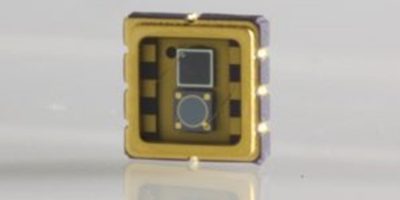Optoelectronics designer and manufacturer, Marktech Optoelectronics has released two indium gallium arsenide (InGaAs) photodiode photodetectors with extended 2.6 micron wavelength responsivity cut offs.
The high speed 2.6 micron InGaAs PIN photodiodes have sensitivity wavelength ranges of 600 to 2,600nm with active area diameters of 1.0mm.
The MTPD2601T-100 InGaAs photodiode is packaged in a TO-46 hermetic metal can with a flat lens and the MTPD2601N-100 InGaAs component uses a TO-46 package with a domed lens. TO metal can packaging provides the highest protection against the ingress of vapour and moisture, said the company, which contributes to reliable, long lifetime InGaAs photodiode detectors.
The 2.6 micron InGaAs photodiode detectors in a TO metal can packages are available now through distributors Digikey Electronics and Mouser Electronics.
Marktech’s InGaAs photodiode manufacturing partner in Japan, Optrans, is recognised as producing some of the industry’s highest integrity visible through SWIR (short wave infra red) detectors.
In addition to standard InGaAs detectors, Marktech can provide many additional services often required to rapidly move a project from the design to the finished product stage, such as detector and emitter selection, application and specification development, InGaAs photodiode customisation, package type selection and custom packages,electro-optical testing and troubleshooting, circuit and assembly design and build and supply of InGaAs photodiodes.
Standard offerings are 1.7 and 2.6 micron but Optrans can tailor the peak responsivity to wavelengths lower than 2.6 micron for applications with sufficiently high annual volumes.
InGaAs PIN photodiodes are available in various package types such as hermetically sealed metal cans (TO-5, TO-18, and TO-39), ceramic SAW packages, pigtail cans, 3mm molded plastic through-hole (flat lens or dome ceramic), and Marktech’s latest enhanced SMD packaging system, the hermetic Atlas package.
Custom-engineered packaging to OEM specifications are also available.
The high sensitivity of InGaAs detectors combined with low noise characteristics (high signal/noise ratio) in the NIR and SWIR wavelengths make InGaAs suitable for medical devices and wearables such as glucose monitoring (non-contact, optical), blood alcohol monitoring, exhaled breath gas analysis, urinalysis. In the field of spectrometry, they can be used for FTIR spectrometry, Raman spectroscopy, tunable diode laser spectroscopy (TDLS), scanning or dispersive NIR spectrometry, non-dispersive infra red (NDIR) spectroscopy, electroluminescence and fluorescence spectrometry, emerging infra red spectroscopy methods, temperature and flame detection, infra red pyrometry or non-contact radiation thermometers, flame and spark detection and regulation, moisture detection and compositional sorting, moisture meters (spectrophotometric), precision agriculture, food sorting and food quality instruments, plastics sorting and recycling.
For photonics test instrumentation, they can be used for coherent measurement systems, IR laser diode characterisation and monitoring, monitoring SWIR LEDs and illuminators, optical power meters, communication receivers in the O, L, and C bands, gas sensing, optical coherence tomography (OCT) and lidar.
Marktech also has capabilities to design and manufacture custom photodetectors to OEM specifications from prototype to production volumes. These include custom photodetector engineering and the manufacturing range includes custom InGaAs photodiodes (wafers, die, packaged InGaAs PDs, and assemblies). In addition, Marktech can co-package InGaAs photodiodes with emitters, filters, thermoelectric coolers (TECs), and transimpedance amplifiers (TIAs).
InGaAs photodiodes from Optrans Japan and silicon photodiodes from Marktech’s Simi Valley plant are assembled in the same package to produce wide spectral band detectors – (SWIR/MIR to mid UVB). This technology makes hybrid InGaAs-silicon detectors with responsivities from 250 to 2,600nm feasible.
https://www.marktechopto.com







